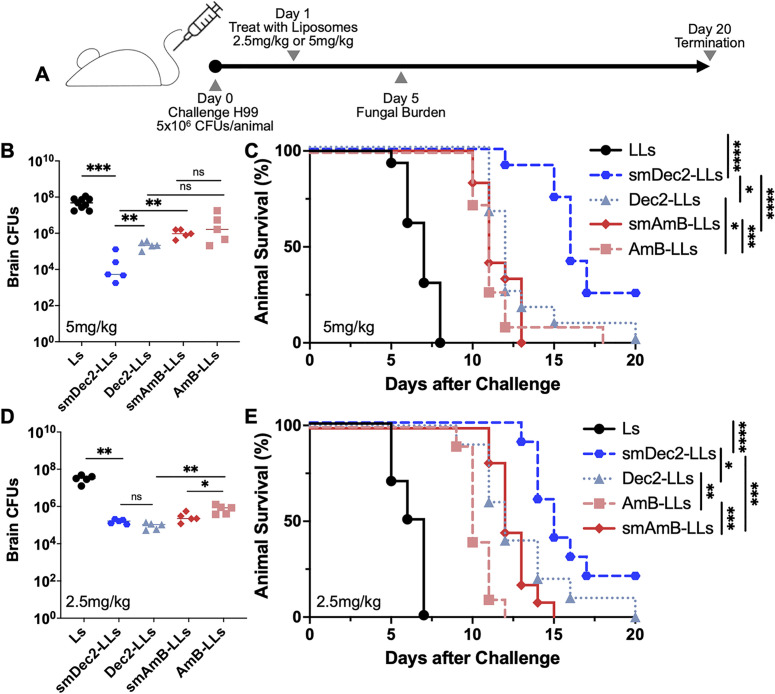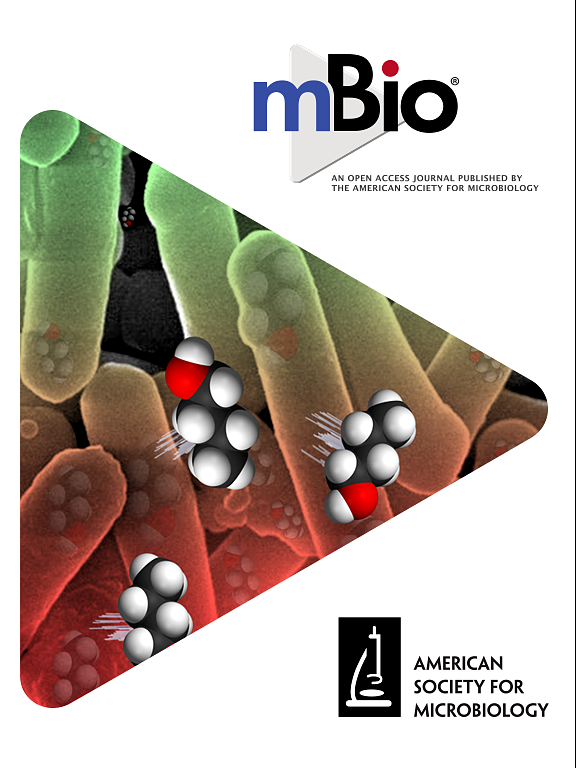小而强大:体积较小的靶向抗真菌脂质体在治疗隐球菌脑膜炎方面更具优势。
摘要
隐球菌脑膜脑炎(CME)是致命的。19%的艾滋病患者死于隐球菌脑膜脑炎,其全球死亡率超过60%。推荐的 CME 治疗需要两性霉素 B(AmB),这是一种针对真菌麦角固醇的杀真菌药物。AmB 也会与宿主的胆固醇结合,毒性很强。相对于脱氧胆固醇溶解的 AmB,脂质体 AmB(AmB-LLs)的毒性更低,组织保留时间更长,但其治疗需要高剂量,治疗 CME 的疗效仍不令人满意。为了提高AmB-LLs的疗效,我们之前开发出了DectiSomes靶向AmB-LLs,该靶向AmB-LLs上装饰有能识别真菌多糖的宿主右旋糖蛋白。与未靶向的 AmB-LLs 相比,DectiSomes 对全身性隐球菌病的疗效改善不大,而在念珠菌病或曲霉病模型中观察到的疗效改善则非常明显。我们推测,普通大小的 DectiSomes 的组织穿透力有限,可能是导致治疗全身性隐球菌病的疗效改善不大的原因。在这里,我们发现,与常规尺寸(约 100 nm)的 DectiSomes 或任何尺寸的非靶向 AmB-LLs 相比,较小尺寸(约 50 nm)的 DectiSomes 在减少包括大脑在内的各器官的隐球菌负担和延长全身性隐球菌病小鼠的存活时间方面具有更好的能力。在两种不同剂量的 AmB 试验中,小型 DectiSomes 的表现远远优于所有其他组别。此外,在测试的任何治疗方案中都没有观察到肾脏毒性。总之,我们的研究结果表明,小 DectiSomes 可以成为一种强大的抗真菌递送平台,大幅改善针对致命隐球菌病的疗法:重要意义:即使采取抗真菌干预措施,全身性隐球菌病也是致命的。治疗这种疾病最有效的药物是两性霉素 B(AmB)。然而,两性霉素 B 有剧毒,因为它会与真菌麦角固醇和哺乳动物胆固醇结合。20 世纪 90 年代,脂质体 AmB 被引入临床,因为它的毒性较低,在各器官中的存留时间较长。然而,使用脂质体制剂治疗所需的 AmB 剂量很高,效果也不尽如人意。在我们之前的工作中,我们生成了 DectiSomes,这是一种装有 AmB 的去克汀饰脂质体,它能更有效地将药物输送到病原体并增强抗真菌效果。然而,与念珠菌病和曲霉病相比,治疗全身性隐球菌病的效果改善不大。在这里,我们生成了只有正常大小一半的 DectiSomes,以提高组织穿透力。我们发现,小的 DectiSomes 在减少包括大脑在内的各种器官的真菌负担和延长动物存活时间方面具有优势。


Cryptococcal meningoencephalitis (CME) is deadly. CME is responsible for 19% of deaths in AIDS patients, and its global mortality is greater than 60%. The recommended CME therapy requires amphotericin B (AmB), a fungicidal drug targeting fungal ergosterol. AmB also binds to the host's cholesterol and is highly toxic. Liposomal AmB (AmB-LLs), relative to deoxycholate-solubilized AmB, has lower toxicity and longer tissue retention, but it requires high doses for treatment and its efficacy in treating CME remains unsatisfactory. To improve the effectiveness of AmB-LLs, we previously developed DectiSomes-targeted AmB-LLs decorated with host dectins that recognize fungal polysaccharides. DectiSomes, relative to untargeted AmB-LLs, modestly improve efficacy against systemic cryptococcosis, in contrast to the drastic improvement observed in candidiasis or aspergillosis models. We speculated that limited tissue penetration of the regular-sized DectiSomes might have contributed to the modest improvement in treating systemic cryptococcosis. Here, we discovered that DectiSomes of a smaller size (~50 nm), compared with DectiSomes of the regular size (~100 nm) or untargeted AmB-LLs of either size, had a much better capability in reducing cryptococcal burden of various organs including the brain and in prolonging the survival of mice with systemic cryptococcosis. The performance of small DectiSomes was far superior to all other groups at two different doses of AmB tested. Furthermore, no kidney toxicity was observed in any of the treatment regimens tested. Taken together, our findings indicate that small DectiSomes can be a powerful antifungal delivery platform to drastically improve therapies against the deadly CME.
Importance: Systemic cryptococcosis is fatal even with antifungal interventions. The most effective drug against this disease is amphotericin B (AmB). However, AmB is highly toxic as it binds to fungal ergosterol and also mammalian cholesterol. Liposomal AmB was introduced to the clinic in 1990s because it showed reduced toxicity and longer retention in various organs. However, the dose of AmB required for treatment using liposomal formulation is high and the outcome is far from satisfactory. In our previous work, we generated DectiSomes, dectin-decorated liposomes loaded with AmB that more effectively deliver the drug to the pathogen and enhance antifungal efficacy. However, the improvement in treating systemic cryptococcosis, compared with candidiasis and aspergillosis, is modest. Here, we generated DectiSomes that are half their regular size to improve tissue penetration. We discovered that small DectiSomes are superior in reducing fungal burden in various organs including the brain and in prolonging animal survival.

 求助内容:
求助内容: 应助结果提醒方式:
应助结果提醒方式:


